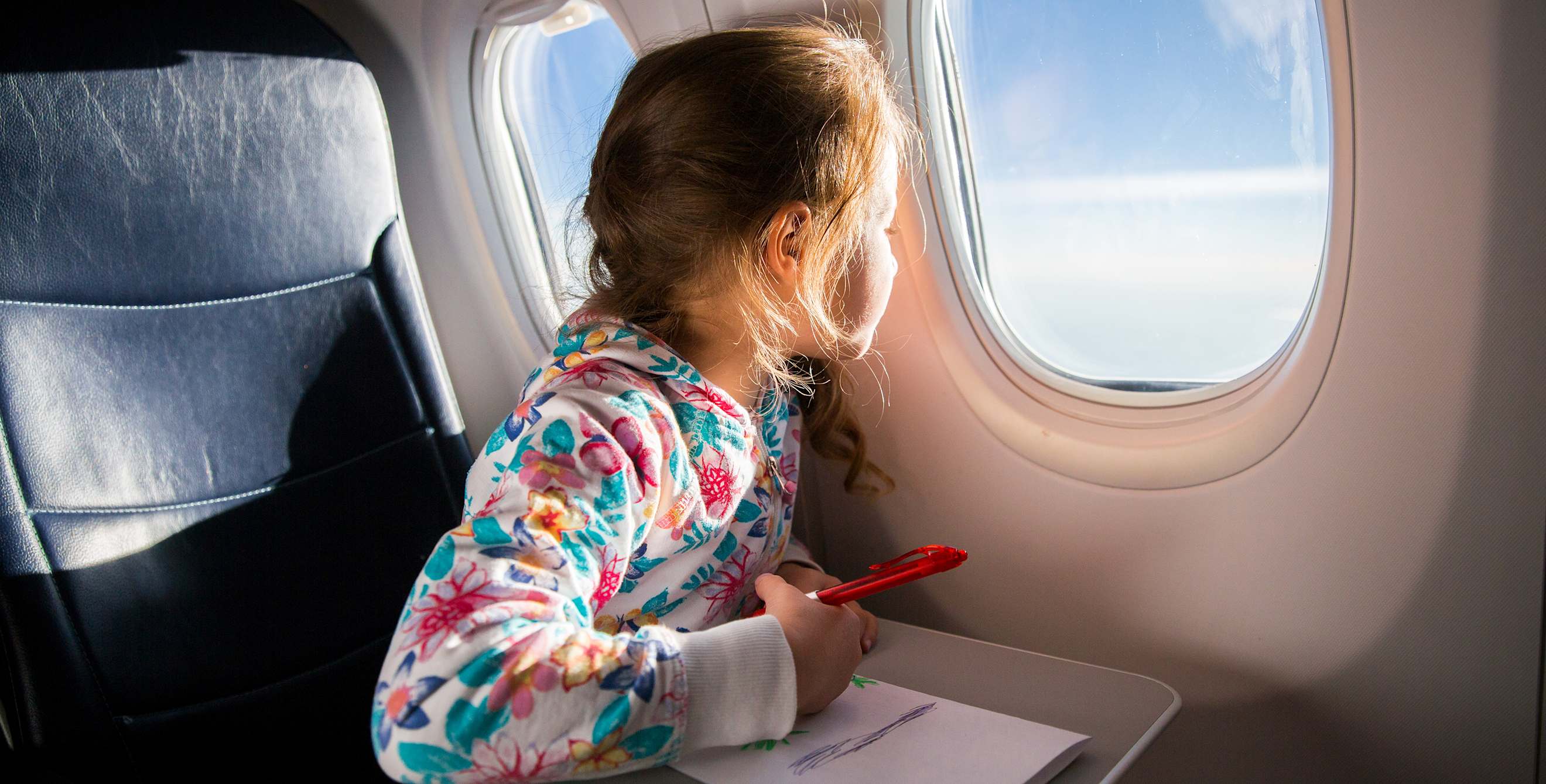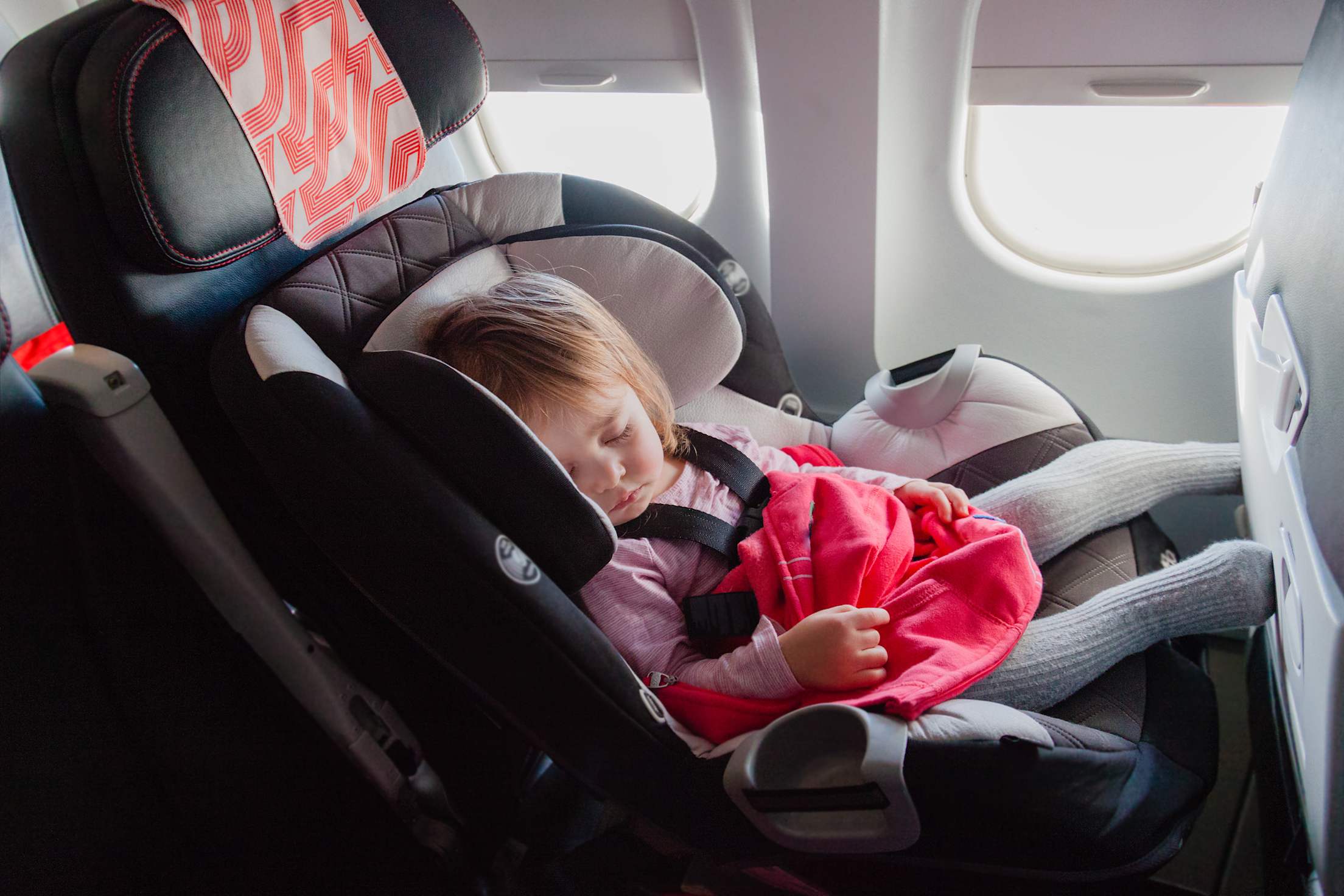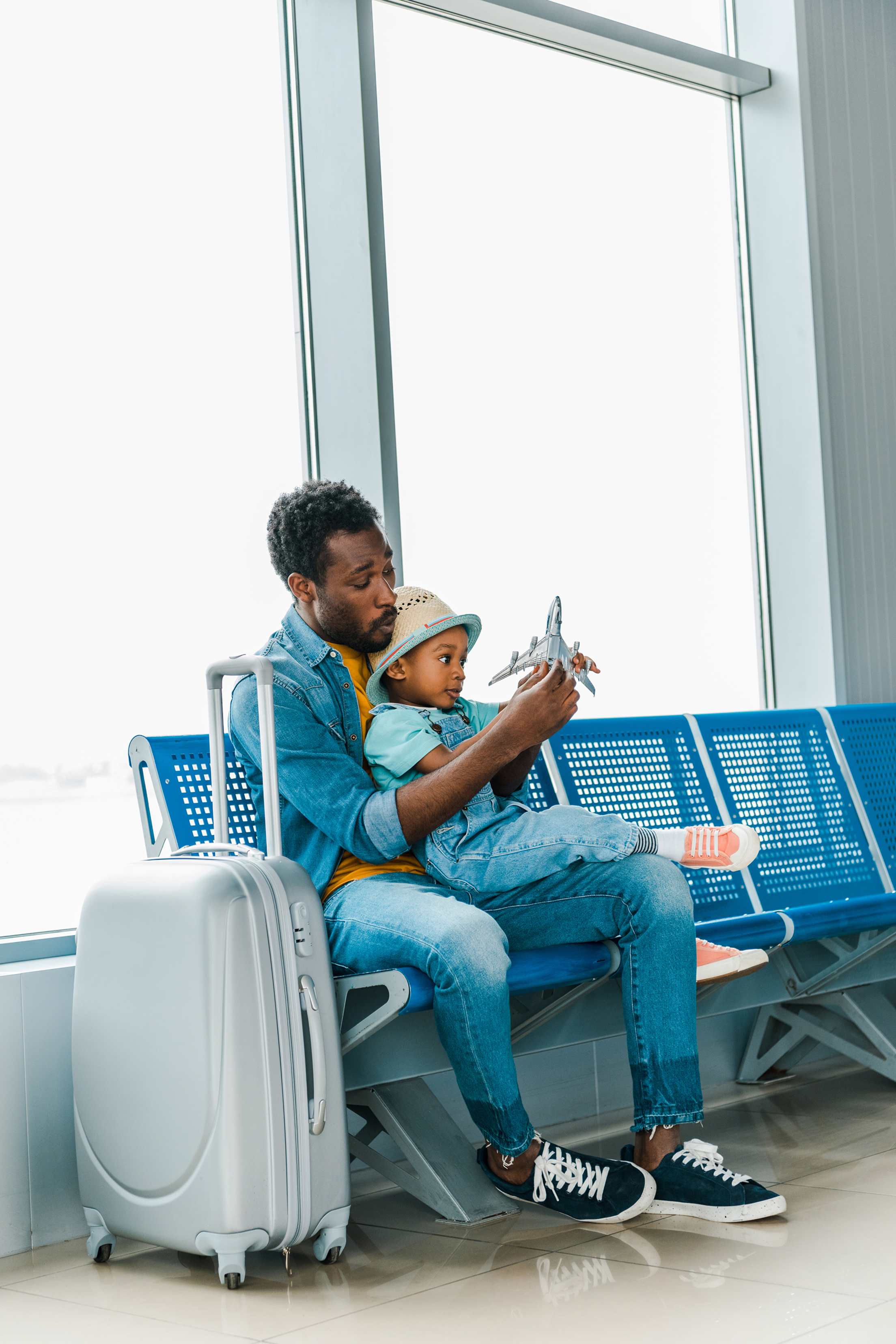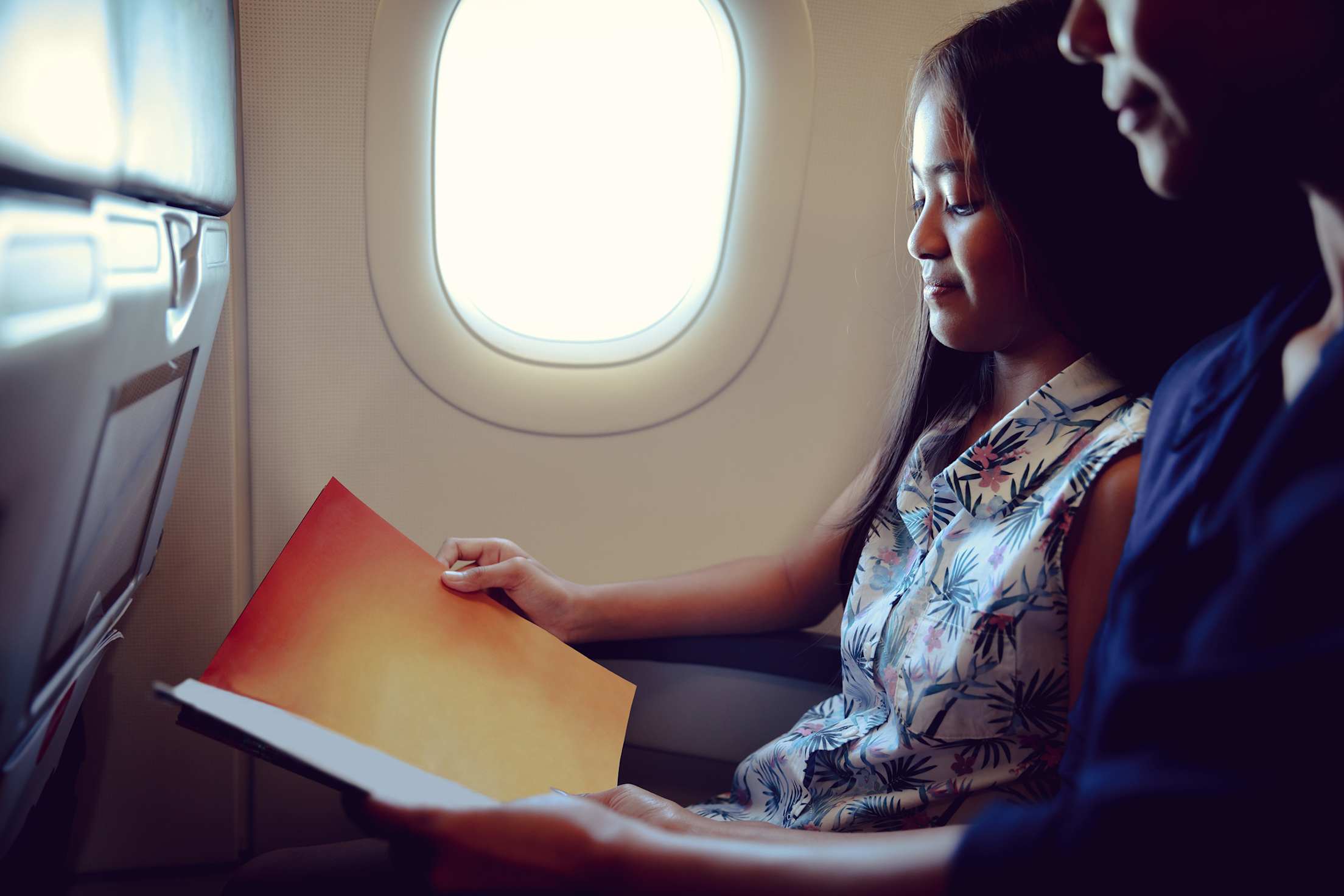
10 Tips for Flying with Kids
Ease stress and keep your infant, toddler, preschooler, or school-aged child happy from security to landing.

Just the thought of flying with children can be stressful. Juggling snacks, diapers, toys, and an active kid is a daunting endeavor. Keeping even the calmest child entertained in a small space for hours at a time may seem like an impossible task. It's no wonder that many feel anxious about parenting at 30,000 feet. Arm yourself with these tips from parents and travel experts on how to keep your kids happy and calm from ticket counter to touchdown.
How to Fly with Infants and Toddlers
1. Turn practice into play.
While it's important for kids of all ages to understand what the trip will entail before they even leave the house, says Samantha Brown, host of the PBS travel show Samantha Brown's Places To Love, acting out what to expect can be especially helpful for toddlers. When her twin boy and girl were first flying, she used her kitchen furniture to mock-up a TSA checkpoint to teach them how to get through security. "Kids need a sense of safety," she says. "You want to put in their minds that this is going to be an adventure." Even just talking to your kids about what will happen in the airport and on the plane will be helpful. Now is the time to explain what they will or will not be allowed to do on the plane, and what is expected of them.
2. Consider buying infants and toddlers their own seat.
Most major domestic airlines allow kids under the age of two to fly for free as a lap child. That's the budget-conscious choice for most families. But, Brown says, for children old enough to crawl or walk, being stuck on a parent's lap for hours at a time can be agonizing. A pricier alternative is to buy an extra seat and use an FAA-approved car seat. Children may be less restless in a seat designed specifically for their bodies, Brown says. Federal aviation rules do not require that children use a car seat, but if you choose to do so, make sure you know how to install it properly with the lap belt before you board.
Smart Tip: You can check if your child’s car seat is FAA-approved by looking at the sticker on the seat or going to the manufacturer’s website.
If you opt to fly with your child in your lap, don't forget to bring a copy of your child’s birth certificate to prove your lap child is under the age of two and their passport if you are traveling internationally.

A car seat can make in-flight naps easier.
3. Give yourself an extra hour.
Get to the airport early to guarantee enough time to go through security with your stroller, carrier, and any baby food. Formula, breast milk, and juice are exempt from the TSA's 3.4 ounce liquid rule when traveling with a child. The TSA limits the volume to a "reasonable amount." All liquids still need to be removed from your bag during screening. Ice packs, gel-filled teethers, and canned, jarred, and processed baby foods are also allowed in your carry-on. Infants, and toddlers can be carried in your arms through the security screening. However, you may be subjected to additional security measures like having your hands swabbed.
Getting to the airport early also gives your toddler a chance to blow off excited energy. Play toss with a balloon, have a snack, or explore airport play areas, which can be found in most major airports, including Las Vegas’s McCarran International Airport, San Francisco International Airport, San Jose Mineta International Airport, and Portland International Airport.
Running low on time? Consider skipping the long line at the ticket counter and check your stroller at the curb if it’s available. You'll need to carry your child the rest of the way through the airport, but it will free your hands for your carry-on and other items. Or wait to check your stroller or seat at the gate before you board. Once through security you'll be able to easily maneuver your little one around the airport, but it does add one more item to deal with in the security line and before you board.
4. Think twice before boarding early.
Despite the temptation to get on the plane early during family boarding, wait until the last minute so your kid is cooped up in a seat for the least amount of time, says Marianne Rogerson of the travel site Mum on the Move. If you’re traveling with another adult, one of you can board early to stow all of your extra gear while the other gets some final wiggles out with your little one.
5. Strategize seating.
Bulkhead seats—the seats just behind the wall that separates economy and first or business class—have extra leg room that allows small children room to move around when the seatbelt sign is off. Some airlines also provide bulkhead bassinets, which are small beds for infants six months and under that attach to the wall in front of you, for long, overnight flights. They must be reserved directly from the airline after you purchase your tickets. While a window seat might provide a great distraction for some young children, an aisle seat, or seats in the rear of the plane, allow easier access to bathrooms. When the seatbelt sign is off, restless toddlers are allowed to walk the aisle in economy class with an adult in between drink and meal services— but stay away from the galleys where flight attendants are working.
6. Have a plan for tantrums.
Combating tantrums starts with a toddler being well rested and fed before the flight. It might sound counterintuitive, but avoid flying during nap time, says Suzi Iverson, co-founder of the family travel site Travel With Monsters. "After the infant stage, I avoid flying during nap times if at all possible. A cranky kid who won’t fall asleep on the plane and has missed his nap is one of the worst possible scenarios," she says.
If a tantrum flares up in the air, you can try distracting or redirecting your child with snacks, sticky notes, calculators, stickers, activity books, a tablet with headphones, magnetic drawing boards, Play-Doh, or quiet toys, such as dolls, cars, or Lego sets. Sometimes the only option is to let the tantrum play out on its own.
In a worst-case tantrum scenario, it's still important to obey flight safety rules. "Make sure that prior to the flight kids understand this, and that safety is not negotiable," says Hilary Stockton, founder of the luxury travel site TravelSort, "so that they're not surprised when you firmly insist that they keep the seat belt fastened."
One popular method for (hopefully) engendering goodwill from nearby seat mates is to pass out goodie bags with earplugs or candy before the flight. But many parents disagree with the practice.
It’s natural for children to become crabby and overwhelmed, says Annie Thompson, mother of three and founder of the interior design site DIY Decor Mom. "Flying is tiring and stressful for most adults, too! There is no reason to be overly concerned about what other people think or to become embarrassed. Anyone who has traveled with children knows how challenging it can be, and will probably be far more understanding than you expect," she says.
While keeping a toddler fed and entertained is a formidable challenge, remember to clean up after your family. Flight attendants will hand out trash bags so you can dispose of snack leftovers and those used-up activity books or sticky notes. Don't throw diapers into the lavatory trash; flight attendants will dispose of them for you.

The gate is a great place to burn off some extra energy while you wait.
How to Fly with a Preschooler
1. Turn your car into an airplane.
Even after the toddler stage, the same tips for little ones still apply—especially helping children prepare for the flying experience in advance. Kate Sullivan, head of experience for the Otis Travel Group, suggests parents practice for flights by taking long car trips. She says you'll encounter many of the same challenges—from potty breaks to not kicking seats—and both parents and children can practice travel etiquette and good communication among the family.
2. Leave early.
Preschoolers can prepare for their travels by packing and carrying a small bag or backpack with a stuffed animal, toy, or other diversions. As with toddlers, plan on extra time at the airport for bathroom breaks—the closer to takeoff the better—and other pre-flight activities.
Don't forget to pack enough snacks. "Snacks can make or break a flight, no matter how long," says nutritionist Lisa Richards. Don't bring kids' favorite sugary snacks assuming they'll stay calm because they're content. Stick with fruits, veggies, and sugar-free drinks, she says, which have the vitamins and minerals that help kids stay calm while avoiding the sugar high and crash.
3. Breeze through TSA.
The American Academy of Pediatrics recommends preparing preschoolers for security ahead of time by talking through how they will put their backpack and any beloved objects in the x-ray bin. TSA helpfully allows children 12 and under to leave their shoes and jackets on during security screenings. However, the TSA's exemption for juice only applies to infants and toddlers. Preschoolers must limit fluids to 3.4 ounces that fit within a quart-sized bag.
Preschoolers are not required to use a car seat, but the FAA recommends using an FAA-approved car seat or child airplane travel harness like CARES, which augments the regular seat belt.

While in-flight entertainment can be a good option, older kids may get bored and need another activity to help time pass.
How to Fly with School-Aged Children
Older children should still fly when they're well-rested, but it's less critical to get to the airport early or prioritize a specific seating arrangement. Once kids can focus for long periods of time on books or movies, flying becomes much simpler, says PBS travel show host Samantha Brown.
While the American Academy of Pediatrics recommends limiting screen time for children 6 and older, many parents throw that advice out the window when it comes to flying. "An airplane is not the place to have a screen time battle," says Natasha Nùñez of the parenting resource site The Artisan Life. "We are a very low-media family but do not restrict the use of the seatback entertainment system while flying." If you are unsure if your aircraft will have in-flight entertainment, you can download shows or movies onto a tablet in advance for easy viewing in the airport or on the plane.
Even then, says Brown, kids get bored watching TV after a while. She brings card games and moulding clay for her now-six-year-old twins. Another tip from Brown: If your flight offers dinner or lunch, order kids' meals on the plane early so that they get served first during meal times.
Whether you're on a new adventure with your family or headed home, your flight is just a small part of the rewarding experience and lifelong memories. Knowing how to handle the ins and outs will keep you calm and cool—and make future flights less stressful and more enjoyable for the whole family.